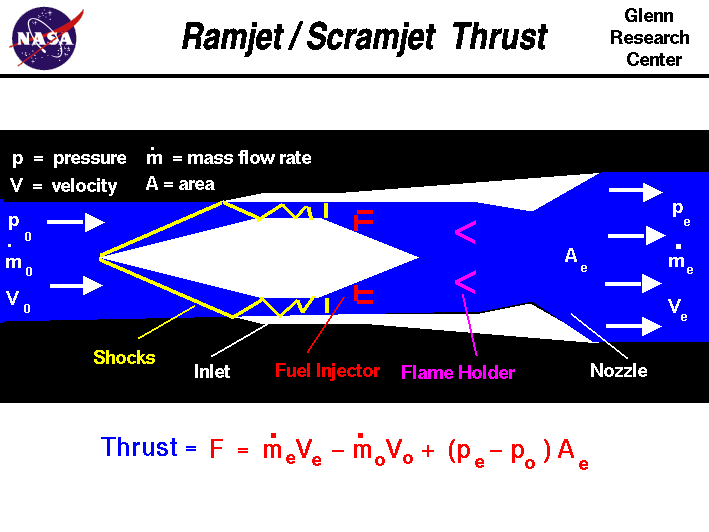
A
ramjet engine provides a simple, light
propulsion system for
high speed
flight.
Likewise, the supersonic combustion ramjet, or
scramjet,
provides high thrust and low weight for
hypersonic flight speeds.
Unlike a turbojet engine, ramjets and
scramjets have no
moving parts, only an inlet, a combustor that consists of a fuel
injector and a flame holder, and a nozzle. How do ramjets and scramjets
work?
When mounted on a high speed aircraft,
large amounts of surrounding air are
continuously brought into the engine inlet
because of the forward motion of the aircraft. The air is slowed
going through the inlet, and the dynamic
pressure due to velocity is converted into higher static
pressure. At the exit of the inlet, the air is at a much higher
pressure than free stream. While the free stream velocity may be
either subsonic or supersonic, the flow
exiting the inlet of a ramjet is always subsonic.
The flow exiting a scramjet inlet is supersonic and has fewer
shock losses
than a ramjet inlet at the same vehicle velocity.
In the burner,
a small amount of fuel is combined with the air and ignited. In a
typical engine, 100 pounds of air/sec. is combined with only 2
pounds of fuel/sec. Most of the hot exhaust has come from the
surrounding air. Flame holders in the burner localize the combustion
process. Burning occurs subsonically in the ramjet and
supersonically in the scramjet. Leaving the burner, the
hot exhaust passes through a nozzle, which
is shaped to accelerate the flow. Because the exit
velocity is greater than the free stream velocity, thrust is
created as described by the general thrust
equation. For ramjet and scramjet engines, the exit mass flow is nearly equal
to the free stream mass flow, since very
little fuel is added to the stream.
The thrust equation for ramjets and scramjets contain three terms: gross
thrust, ram drag, and a pressure correction. If the free stream conditions
are denoted by a "0" subscript and the exit conditions by an "e" subscript,
the thrust F is equal to the mass flow rate m dot
times the velocity V at the exit minus the free stream mass flow rate
times the velocity plus the pressure p difference times the nozzle
exit area:
F = [m dot * V]e - [m dot * V]0 + (pe - p0) * Ae
- Aerodynamicists often refer to the first term (exit mass flow
rate times exit velocity) as the gross thrust, since this
term is largely associated with conditions in the nozzle.
- The second term (free stream mass flow rate times free stream
velocity) is called the ram drag. This term can be quite large
for scramjet engines.
-
For ramjets and scramjets, the nozzle exit
velocity is supersonic, and the exit pressure depends on the area
ratio between the throat of the nozzle and the exit
of the nozzle. Only for a unique design condition is the exit
pressure equal the free stream static pressure.
For all other conditions, we must include the third term of
the thrust equation (exit pressure minus free stream pressure
times the exit area). This pressure correction is usually
small compared to the first term of the thrust equation. But for
completeness, this term is usually included in the gross
thrust.
You can explore the design and operation of a ramjet
engine by using the interactive
EngineSim
Java applet. Set the Engine
Type to "Ramjet" and you can vary any of the parameters which
affect thrust and fuel flow.
You can also explore the design and operation of a ramjet nozzle with
our interactive nozzle simulator program
that runs on your browser.
Activities:
Guided Tours
Navigation ..


- Beginner's Guide Home Page
|
